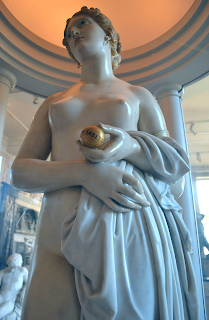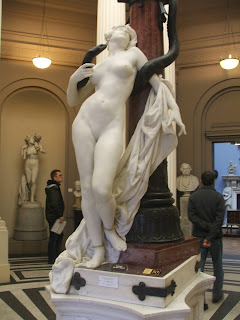KNIDIAN APHRODITE & TINTED VENUS: STATUES OF THE MONTH MARCH 2020
PREPARE TO BE SHOCKED: KNIDIAN APHRODITE & TINTED VENUS
STATUES OF THE MONTH: MARCH 2020
This month we’re going to look at a pair of nude statues -
one Classical, one Victorian – depicting the goddess Aphrodite (aka
Venus). These statues are linked not
just by their subject-matter, and by the likelihood that one was intended as a
homage to the other, but by the impact they had when first exhibited, as they were
both considered to be shocking and radical pieces of work.
Praxiteles: Knidian
Aphrodite
If you’ve ever studied an A-level or undergraduate module on
Classical Sculpture, you’ll probably remember spending 90% of your course
looking at sculptures of nude men (give or take the odd clothed statue of a
charioteer). In the last few weeks of
the course, you begin to get the odd glimpse of female thigh (Scopas’s Raging Maenad) or the occasional breast
slipping out while Nike zooms through the air at Olympia
Like his Apollo
Sauroktonos (Apollo the Lizard-Slayer, featured as February 2020’s Statue
of the Month), Knidian Aphrodite
features Praxiteles’s technique of ‘humanising the gods’ by showing them
engaged in an everyday activity, in this case bathing. Like the tree in Apollo Sauroktonos, Knidian
Aphrodite also includes a built-in support to the left of the figure - Aphrodite’s
dress cascading over a hydria (a
water-jar). Her long hair is bound up in
a chignon, and her only accessory is an armlet around her left bicep. This statue is based on a voyeuristic premise:
that we’ve walked in on Aphrodite while she’s having a wash. Voyeurism is a common theme in Greek
mythology (Artemis and Actaeon) and anecdotal history (Herodotus’s story of
Gyges and the Ring, probably best known to a modern audience through its
appearance in the film The English
Patient). Our incursion into a
private moment explains why Aphrodite is grabbing her dress and attempting to
cover her crotch with her hand.
But even though her body language implies embarrassment, the expression
on her face is one of quiet amusement: was she half-expecting us? As she’s not looking directly at the viewer,
but slightly downwards and to her left, we have to walk round the statue in
order to make eye-contact with her.

Left: Roman copy of Knidian Aphrodite, Glyptothek, Munich
Right: Plaster cast of Knidian Aphrodite, Royal Cast Collection, Copenhagen
This statue attracted a whole raft of stories in antiquity,
including the explanation of the name by which it is still known. The citizens
of Kos , who had originally commissioned the
statue, were so shocked when they saw the finished product that they refused to
accept it. At this point another Greek
city stepped in – Knidos, located on a peninsula further down the coast of Asia Minor – and offered to take the statue. It has been suggested that the people of
Knidos, as Dorians, had links with Sparta and were therefore less hung-up about
female nudity than the residents of most ancient Greek states (as girls
competed nude in Spartan athletic contests).
The people of Knidos realised that they had the potential to create a
major tourist attraction: they created a purpose-built round temple in which to
display the statue, and encouraged tourists from all over the Greek world to
come and see it.
Other stories quickly grew up around the statue. It was said that Praxiteles’s model was his
mistress Phryne, the top Athenian hetaira
(a high-class courtesan, or highly-educated escort) of her day. A young man supposedly became so besotted by
the statue that he tried to make love to it, then committed suicide by throwing
himself off a cliff, having left incriminating stains on the statue’s marble
thighs. A Hellenistic king offered to
wipe out Knidos’ national debt in exchange for the statue (they refused). The statue may even have helped to shape
Greek mythology – the story of Pygmalion and Galataea can only be traced back
as far as the 3rd century BC, after
this statue was made, suggesting that Praxiteles’s work may have inspired
the story of the beautiful marble statue of a naked woman which comes to life
(and of course makes a far superior wife to any of the real women that Pygmalion encounters).
Given that Aphrodite is the personification of desire, the
statue also gives us an insight into what was considered an attractive
body-shape for women in 4th century Athens
Sadly, the original marble statue which inspired such
excitement has long since disappeared, leaving us with rather pedestrian Roman
copies which probably fail to capture the beauty of the original. The most accurate surviving copy is probably
the one which Hadrian commissioned for the grounds of his villa at Tivoli , near Rome
John Gibson: Tinted
Venus
We’re now going to fast forward over two thousand years, to
consider a Victorian statue which created almost as much of a stir as
Praxiteles’s work. John Gibson’s Tinted Venus (1851-56) forms the
centrepiece of the Sculpture Room at the Walker Art Gallery in Liverpool, displayed
in its own purpose-built circular shrine – inspired, of course, by the circular
shrine created for Knidian Aphrodite.
Gibson’s statue also shows Aphrodite naked, interrupted
while bathing or dressing. Her dress
hangs over her left arm, covering her crotch and providing additional support
for the statue. Her hair is swept up off
her neck, held in place by a net. Like
Praxiteles’s work, she has jewellery: a golden armlet around her left arm and
golden earrings which fall in tiny droplets.
Gibson, though, has added two items which weren’t present in
Praxiteles’s work: a tortoise and an apple.
The tortoise can be found at the base of the statue, by Aphrodite’s left
foot, and it’s inscribed with the Greek legend: ΓΙΒΣΩΝ ΕΠΟΙΕΙ ΕΝ ΡΩΜΗ: ‘Gibson
made (me) in Rome
The gilded apple which Aphrodite is holding in her left hand
is the apple awarded to her by Paris
Before exploring the statue further, let’s have a quick look
at John Gibson himself, as a fantastic British sculptor whose work deserves to
be better known. Although he was born
near Conwy in North Wales, he spent his formative years in Liverpool, the
result of an abortive attempt by his family to emigrate to America Rome Rome Rome Rome Rome in 1866 and he’s buried in the Protestant Cemetery Royal Academy in London
One couple who
visited Gibson’s Roman studio, a Mr & Mrs Preston from Liverpool ,
commissioned the Tinted Venus from
him in 1851. However, Gibson supposedly
became so taken by the statue (a modern-day Pygmalion?) that he couldn’t bear
to let it leave his studio, so it wasn’t exhibited until 1862. When it finally went on show, it proved
controversial because he’d added subtle colour to the marble, in line with the
latest research which proved that Greek statues had originally been
painted. By the 1850s most Classical art
historians accepted that Greek statues had been polychromatic, but this idea
had yet to percolate through to the general public. We now
know that Gibson’s use of colour was actually pretty mild compared to the
rather garish colour-schemes used on Classical Greek sculpture. The picture
below, for example, shows a reconstruction of a section of the Parthenon, in
the British Museum
Trojan archer from the East pediment of the Temple of Aphaia, Aegina.
Painted cast, reconstructing the original paint job, Glyptothek, Munich
Trojan archer from the East pediment of the Temple of Aphaia, Aegina.
Painted cast, reconstructing the original paint job, Glyptothek, Munich
The statue made its debut at the
London International Exhibition in South Kensington ,
displayed in a ‘temple’ specially designed for it by Owen Jones (author of an
early design sourcebook, The Grammar of
Ornament). It was returned to the
Preston family after the exhibition and eventually acquired by the Walker Art
Gallery
The Athenaeum reviewer’s suggestion that Gibson might have
used an English model for his statue fascinated me so much that in 2019 I wrote
a short story about Tinted Venus,
which I’ve also posted as a separate item on this blog. You might recognise the source of some of the
dialogue from the biographical notes above!
Where to See Gibson’s Work
John Gibson’s Tinted Venus still forms the centrepiece of the Sculpture Hall at
the Walker Art
Gallery , Liverpool
(completely free and well worth a visit, if you’ve never been). Other works by Gibson can be found in many
British museums and stately homes, including:
Chatsworth Sculpture
Gallery: Mars Restrained by Cupid
Fitzwilliam Museum,
Cambridge: Venus Verticordia
(essentially an earlier, uncoloured version of the Tinted Venus)
National Museum of
Wales: Phaeton Driving the Chariot of the Sun (relief by Gibson, c 1848); Aurora (free-standing statue, c 1842); Wounded Amazon (marble free-standing
sculpture, c 1840)
Left: Gibson's marble statue of Meleager the Hunter, in Norwich Castle Museum
Right: Gibson's plaster model for the same statue, part of his bequest to the Royal Academy

















Comments
Post a Comment